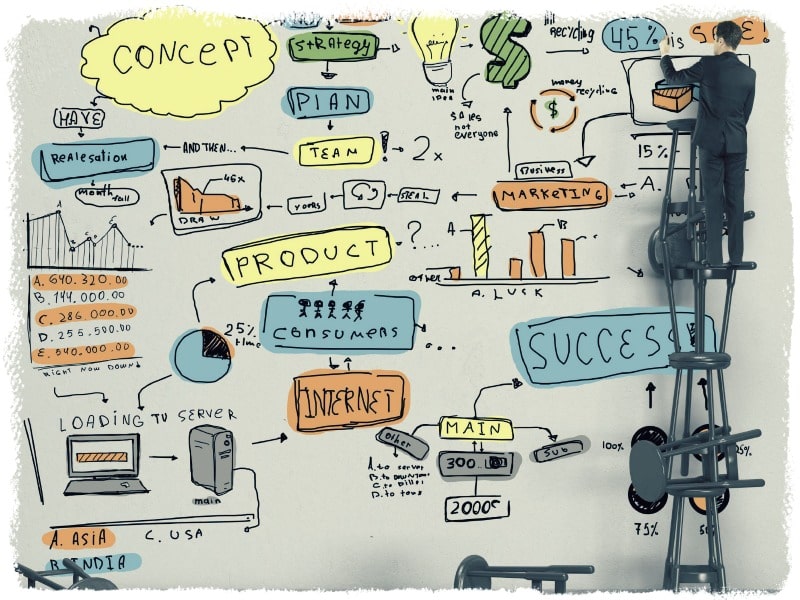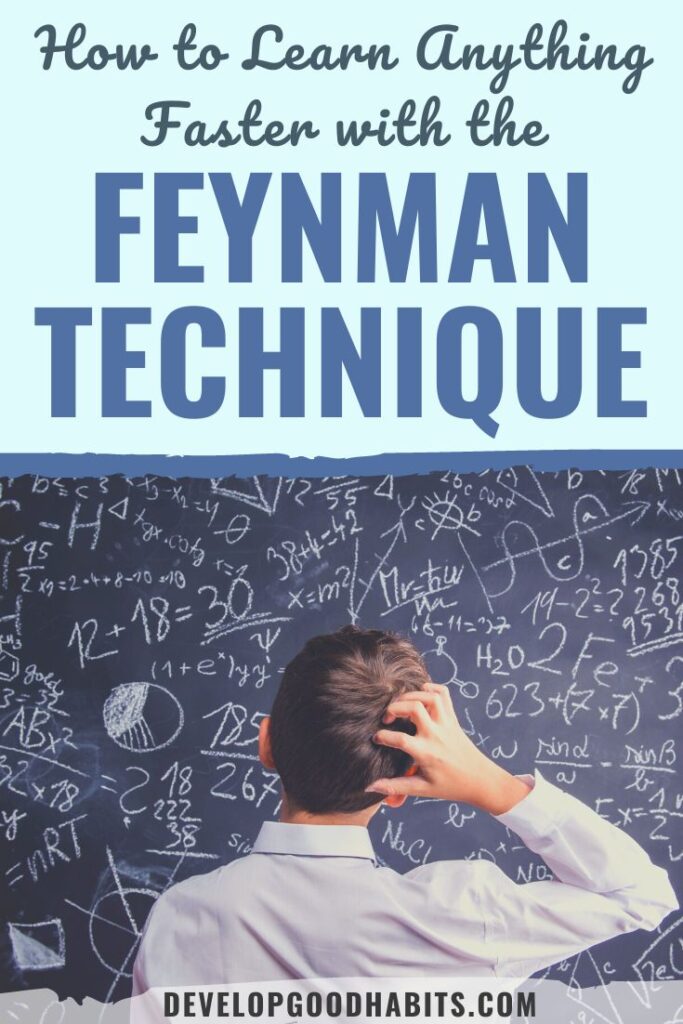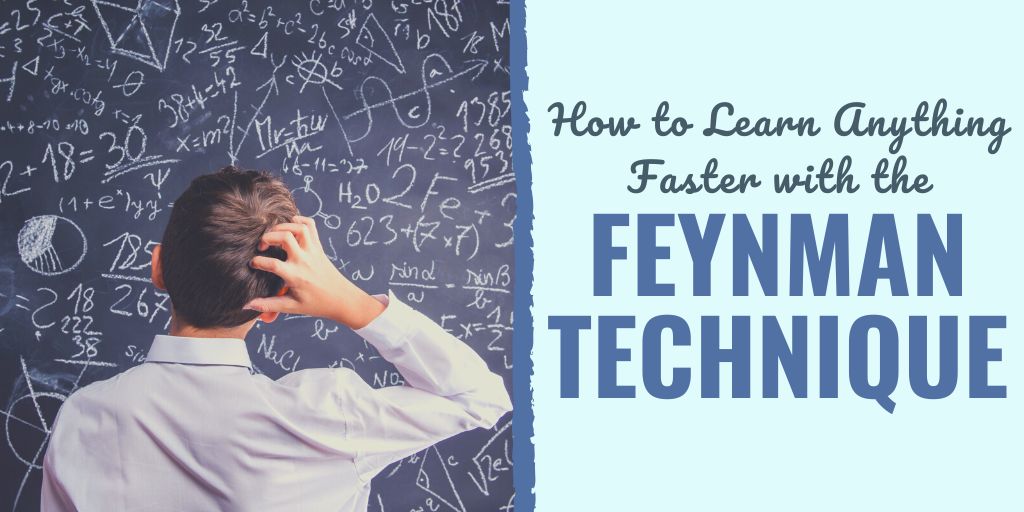There might be affiliate links on this page, which means we get a small commission of anything you buy. As an Amazon Associate we earn from qualifying purchases. Please do your own research before making any online purchase.
As a student (or someone interested in lifelong learning), there are many things competing for your attention. These can become major distractions whenever you need to concentrate.
Fortunately, there are numerous learning tools that are proven to be effective in boosting your ability to fully comprehend your lessons.
One such strategy that helps students understand lessons without having to slave over highly technical material is the Feynman Technique.
The process takes 15 minutes to master and can help you absorb and comprehend complex study materials better than poring over textbooks for hours on end. All you need is a blank notebook and a pen or pencil.
Let’s talk about this strategy and how it can help improve your study habits.
What Is the Feynman Technique?
Have you ever had a teacher or coworker who spoke in only technical terms, or would explain things with language that was really challenging to understand? You probably weren't able to learn much from that person because you could hardly follow what they were saying.
When people talk about the Feynman Technique of problem solving, they often quote Albert Einstein’s famous words:
“If you can’t explain it simply, you don’t understand it well enough.”
This means that if you are able to explain a complex concept in simple terms, you have a good understanding of the concept at hand.
Doing this will also help you recognize your problem areas or areas of confusion, because this will be where you either get stuck when explaining the concept or where you have to resort to using complex terminology.
The Feynman Technique is the perfect strategy for learning something new, deepening your understanding of a concept, enhancing your recall of certain ideas, or reviewing for tests.
This mental model was named after the Nobel prize-winning physicist Richard Feynman, who was recognized as someone who could clearly explain complex topics in a way that everybody—even those without degrees in the sciences—could understand.
He was able to take the mystery out of complex scientific principles. Feynman was also named “The Smartest Man in the World” by Omni magazine in 1979.
While studying at Princeton, Feynman began recording and connecting the information he knew with the things that he either didn't know or didn't understand. In the end, he had a complete notebook of topics and subjects that he had disassembled, translated, reassembled, and written down in simple terms.
Although the technique was used by a physicist, that doesn’t mean that it is impossible for others to utilize the Feynman Technique as an effective tool for learning faster. Anyone can use this technique to:
This learning strategy is effective for quickly learning both technical and non-technical concepts, and is summarized in four succinct steps.
What Are the Benefits of the Feynman Technique?
There are several benefits to using this learning technique.
First, it helps you gain a complete understanding of what you're learning. Once you fully understand the information at hand, you are better equipped to make informed and intelligent decisions regarding the subject.
Taking this one step further, you can use the Feynman Technique if you are struggling with the tough subject matter, which is one of the largest obstacles to learning.
Using the Feynman Technique allows you to apply the concepts that you learn to real-world problems because you are able to grasp the concepts and processes of complex ideas.
It also helps to improve your teaching skills, as you use this technique to essentially teach yourself the fundamentals of a subject (which was what these famous autodidacts did). This also increases your capacity to use critical thinking skills about a topic.
Feynman’s Technique is especially beneficial for people who find writing to be a challenge. Feynman did not prefer to write his knowledge down on paper as many scientists do.
Instead, he used verbal communication as the foundation for the majority of his published works. He preferred to dictate his books and memoirs, and the scientific papers that are credited to him were transcribed from his lectures.
Feynman relied heavily on verbal communication, such as when he used cartoonish diagrams to explain highly scientific principles.
Feynman could easily tap into complex ideas using shapes, lines, and drawings. This method helped him strip away the confusing language and permitted the power of storytelling to take precedence.
The 4 Steps of the Feynman Technique
Here are the four core steps used in the Feynman Technique to accomplish your learning goals.
1. Pick a topic or concept that you want to learn.
Choose the idea or concept that you want to learn about, understand deeper, or quickly recall during examinations.
Write the concept as a heading on a blank piece of paper or a notebook page.
After choosing the concept, write down everything that you already know about the subject in your paper. Think of every small piece of information that you can recall about the subject or have learned in the past. Keep this sheet handy to continue to write down what you learn.
2. Teach it to a new student.
Imagine that you are tasked with teaching the concept to a new student.
Explain the concept using your own words, pretending that you are teaching it to someone else. Make sure that you use plain, simple language, without limiting your teaching to simply stating a definition.
Put yourself up to the challenge of explaining an example or two of the subject to make sure that you can apply the concept to real life.

3. Review and fill in the gaps.
Don't worry if you get stuck when practicing step #2. You are just starting to learn, so it won't all come to you immediately.
Review the explanation that you came up with, and pinpoint the areas where you were not clear or you felt your explanation was shaky.
Then, return to your source material and notes to better your understanding. Practice step #2 again with your new, revised notes.
4. Simplify.
Make sure that you are able to explain this to someone who knows nothing about the subject.
To do this, you will want to use simple terms when you write the ideas or concepts in your own words. While complex, subject-specific jargon sounds cool, it confuses people and urges them to stop paying attention.
Replace technical terms with simpler words, and think of how you could explain your lesson to a child.
Children are not able to understand jargon or dense vocabulary. Because science is filled with complex terms, Feynman’s diagrams became valuable to people who were struggling to teach and to people who were struggling to understand. His charts were able to simply explain things that other scientists took hours to lecture students on in an attempt to teach them.
If a concept is highly technical or complicated, analogies are also a good way to simplify them. Analogies are the foundation of learning from experience, and they work because they make use of your brain's natural inclination to match patterns.
Analogies influence what you perceive and remember, and help you process information more easily because you associate it with things you already know. These mental shortcuts are useful methods of processing new and unfamiliar information and help people understand, organize, and comprehend incoming information.
One example of an analogy created by Feynman encapsulates the power of his technique. He was able to take a question regarding human existence and simplify it into a simple sentence that even a middle-schooler could understand. Feynman said:
“All things are made of atoms—little particles that move around in perpetual motion, attracting each other when they are a little distance apart, but repelling upon being squeezed into one another.”
Here, Feynman is saying that if you don't know anything about physics, the most important concept to understand is that everything is composed of atoms.
In one sentence, he communicates the fundamental existence of the universe. This is a genius ability—not only for scientists but also for writers of any subject. Get to your point as succinctly as possible, and avoid confusing and verbose language.
Does the Feynman Technique Work for Everything?
Not exactly. If you are trying to memorize something, this is not the technique to use.
The Feynman Technique is more about giving yourself that “Aha!” moment when you finally put all the pieces together to understand something. Using flashcards or mnemonics are more effective strategies for memorization.
This is also not a good technique to use on concepts that you already find to be simple or easy to understand.
How to Apply the Feynman Technique to Your Study Habits
Now that you know what the Feynman Technique is, let's look at how to apply it. While this technique is most commonly used to help people understand difficult math concepts, it can really be used with any complex concept.

1. Identify lessons you don't fully understand.
You can use the technique to go over your notes and identify the specific parts of a lesson that are vague to you.
This is especially helpful when you are trying to understand challenging concepts or complex interactions, such as when math and physics are combined.
Knowing where you have gaps in knowledge is the point where true learning occurs. What doesn't make sense, or what piece of the puzzle is missing? Highlighting your gaps in knowledge will help you organize your notes into a cohesive narrative.
2. Create simple analogies to enhance your recall of concepts.
Using one of the many Feynman Technique examples, you can create an analogy to understand the concept of torque. Torque is a force that rotates an object.
To create an analogy to help you understand the concept of torque, you can think about drilling a nail into wood. The common phrase, “Righty tighty, lefty loosey” is a great analogy to help you recall this concept.
If possible, try to come up with your own analogy to help understand and explain the topic at hand. Using analogies when teaching forces you to meet your listeners where they are in terms of their level of understanding, and relate something they already know to the new concept you are teaching.
For example, let's say you are using some Feynman tricks to explain how to write a story. You may make it simple by reducing the concept of a story to the simple structure of a pyramid.
The image of a pyramid can communicate complex information to a student in a simple way because they can relate a story's structure to a shape they are familiar with.
This shape gives students an intuitive understanding of the tension that builds in a good story and eventually reaches a climax before becoming resolved or diffused in some way. Being able to come up with an analogy like this forces you to understand a concept well enough to relate it to an idea you're already familiar with.
3. Use it in a small group setting.
Using the Feynman Technique without looking up your source materials is a good way to test your comprehension of a topic and is ideal for self-testing before an exam.
A great way to practice this is to get into a small study group and take turns teaching each other the material that will be on your exam. If everyone in the group gets stuck on an idea, work together to simplify it until it is clear to everyone.
Explaining these concepts to your classmates or friends will not only stimulate your senses, but it will also provoke emotional responses that help you retain the information.
Group studying is not always effective, but when using the Feynman Technique in a small group setting, it can benefit everyone who is involved. However, you always have to remember to find the study environment that works best for you.
To self-test, go through all of the information that you are trying to learn without referencing your notes. See how far you can get in explaining the concepts without getting stumped.
The Feynman Technique forces you to completely understand a concept because otherwise, you wouldn't be able to explain it to a child. In this way, the information is ingrained in your memory.
To quote John Medina, a leading expert on cognitive studies and the founding director of two brain research institutes, “The more a learner focuses on the meaning of the information being presented, the more elaborately he or she will process the information. This principle is so obvious that it is easy to miss.”
Final Thoughts on the Feynman Technique
The Feynman Technique is a helpful learning tool that requires you to challenge your own understanding to enhance your recall of complex topics, break down the complexity of a lesson into easily understood points, and provide an opportunity to really absorb learning materials and concepts.
As you are able to grasp ideas and concepts quickly, no matter how complex they are, your academic performance will definitely show an improvement.
By constantly practicing the Feynman Technique, you will be able to develop good learning habits that will improve the effectiveness of the time you spend hitting the books.
If you are interested in learning more effective study habits, be sure to check out these blog posts:
- 13 Effective Study Habit Examples: Improve Your Study Routine
- 27 Free Study Plan Templates to Edit, Download, and Print
- The Ultimate Guide to Creating the Perfect Study Schedule
Finally, if you want to take your goal-setting efforts to the next level, check out this FREE printable worksheet and a step-by-step process that will help you set effective SMART goals.



I find that the idea of teaching a concept to someone else makes it a lot easier to understand it.
I tend to focus on key words, linkages and the bigger picture when I do so.
A friend of mine knows this too and he’ll always ask me which concepts I’m not sure of when a quiz is coming up and teach me to solidify his own understanding!